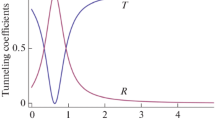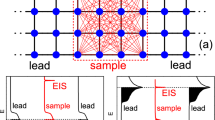Abstract
We consider a quantum particle in a double-well potential, for simplicity in the two-level approximation, coupled to a phonon field. We show that static and dynamical ground state correlations of the particle and of the field are expressible through expectations in an Ising model over ℝ (rather than ℤ). Its free measure is a spin flip process with flip rate ɛ, the difference in energy between the ground state and the first excited state. The Ising model has a ferromagnetic pair interaction whose form depends on the couplings to the phonon field and on the dispersion relation of the phonon field. In physical applications the interaction is long ranged and decays ast −2 for large distances. In this case we prove that for sufficiently strong coupling the particle becomes localized in one of the wells. The effective tunnel rate is zero. The transition to localization is associated with the generation of an infinite number of low momentum phonons. We apply the Ising technology to our problem and discuss the phase diagram in some detail.
Similar content being viewed by others
References
G. Jona-Lasinio, F. Martinelli, and E. Scoppola,Commun. Math. Phys. 80:223 (1981).
G. Yuval and P. W. Anderson,Phys. Rev. B9:1511 (1970).
V. J. Emery and A. Luther,Phys. Rev. B 9:215 (1974).
J. Fröhlich and T. Spencer,Commun. Math. Phys. 84:87 (1982).
P. W. Anderson, G. Yuval, and D. R. Hamann,Phys. Rev. B 1:4464 (1970).
E. B. Davies,Commun. Math. Phys. 39:91 (1974).
R. Beck, W. Götze, and P. Prelovsek,Phys. Rev. A 20:1140 (1979).
P. Pfeifer, Chiral molecules—A superselection rule induced by the radiation field, Ph.D. thesis, ETH Zürich (1980).
A. O. Caldeira and A. J. Leggett,Phys. Rev. Lett. 46:211 (1981).
A. O. Caldeira and A. J. Leggett,Ann. Phys. (N.Y.) 149:374 (1983).
S. Langer,Ann. Phys. (N.Y.) 41:108 (1967).
C. G. Callan and S. Coleman,Phys. Rev. D 16:1762 (1977).
H. Grabert, U. Weiss, and P. HÄnggi,Phys. Rev. Lett. 52:2193 (1984).
S. Chakravarty,Phys. Rev. Lett. 49:681 (1982).
A. J. Bray and M. A. Moore,Phys. Rev. Lett. 49:1545 (1982).
S. Chakravarty and S. Kivelson,Phys. Rev. Lett. 50:1811 (1983).
W. Zwerger,Z. Physik B—Condensed Matter 53:53 (1983).
W. Zwerger,Z. Physik B—Condensed Matter 47:129 (1982).
D. Forster,Hydrodynamic Fluctuations, Broken Symmetry and Correlation Functions (Bejamin, New York, 1975).
F. J. Dyson, inStatistical Mechanics at the Turn of the Decade, E. G. D. Cohen, ed. (Marcel Dekker, New York, 1971).
F. J. Dyson,Commun. Math. Phys. 12:91 (1969).
F. J. Dyson,Commun. Math. Phys. 21:269 (1971).
D. Ruelle,Commun. Math. Phys. 9:267 (1968).
F. J. Dyson,Commun. Math. Phys. 12:212 (1969).
J. B. Rogers and C. J. Thompson,J. Stat. Phys. 25:669 (1981).
D. Ruelle,Ann. Phys. (N.Y.) 69:364 (1972).
B. Simon,Functional Integration and Quantum Physics (Academic Press, London, 1979).
B. Simon,Commun. Math. Phys. 77:111 (1980).
J. Fröhlich and C. A. Pillet, private communication.
B. Simon and A. D. Sokal,J. Stat. Phys. 25:679 (1981).
A. D. Sokal,J. Stat. Phys. 28:431 (1982).
J. L. Lebowitz,Commun. Math. Phys. 35:87 (1974).
C. M. Newman,Z. Wahrscheinlichkeitstheorie verwi. Gebiete 33:75 (1975).
G. S. Sylvester,Commun. Math. Phys. 42:209 (1975).
J. Bricmont,J. Stat. Phys. 17:289 (1977).
D. Brydges, J. Fröhlich, and T. Spencer,Commun. Math. Phys. 83:123 (1982).
R. B. Griffiths,J. Math. Phys. 8:478 (1967).
R. B. Griffiths,J. Math. Phys. 8:484 (1967).
R. B. Griffiths,Commun. Math. Phys. 6:121 (1967).
F. Leyvraz and P. Pfeifer,Heb. Phys. Acta 50:857 (1977).
D. Ruelle,Statistical Mechanics (W. A. Benjamin, Reading, Massachusetts, 1969).
J. Glimm and A. Jaffe,Quantum Physics—A Functional Integral Point Of View (Springer, Berlin, 1981).
D. Wells, thesis, Department of Mathematics, Indiana University, 1977, unpublished.
J. Bricmont, J. L. Lebowitz, and C. E. Pfister,J. Stat. Phys. 24:269 (1981).
G. Gallavotti and H. Knops,Riv. Nuovo Cimento 5:341 (1975).
P. Collet and J. P. Eckmann,A Renormalization Group Analysis of the Hierarchical Model in Statistical Mechanics (Lecture Notes in Physics No. 74, Springer, Berlin, 1978).
J. Bhattacharjee, S. Chakravarty, J. L. Richardson, and D. J. Scalapino,Phys. Rev. B 24:3862 (1981).
G. Lindblad,Commun. Math. Phys. 40:147 (1975).
J. Voigt,Commun. Math. Phys. 81:31 (1981).
J. L. Cardy,J. Phys. A: Math. Gen. 14:1407 (1981).
J. M. Kosterlitz,Phys. Rev. Lett. 37:1577 (1976).
K. Hepp and E. H. Lieb,Phys. Rev. A8:2517 (1973).
K. Hepp and E. H. Lieb,Ann. Phys. (N.Y.) 76:360 (1973).
O. E. Lanford and D. W. Robinson,Commun. Math. Phys. 24:193 (1981).
D. W. Robinson,Commun. Math. Phys. 31:171 (1973).
E. B. Davies,Lett. Math. Phys. 1:31 (1975).
R. P. Feynman,Statistical Mechanics, Frontiers in Physics (W. A. Benjamin, Reading, Massachusetts, 1972).
M. D. Donsker and S. R. S. Varadhan,Commun, Pure and Appl. Math. 36:505 (1983).
B. Simon,J Stat. Phys. 26:307 (1981).
Author information
Authors and Affiliations
Rights and permissions
About this article
Cite this article
Spohn1, H., Dümcke1, R. Quantum tunneling with dissipation and the Ising model over ℝ. J Stat Phys 41, 389–423 (1985). https://doi.org/10.1007/BF01009015
Received:
Issue Date:
DOI: https://doi.org/10.1007/BF01009015




